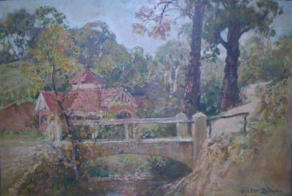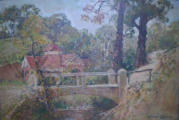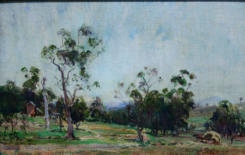


© Meg Dillon 2008
Australian Colonial History

Master Printmakers of 1920s & 1930s
Victor Zelman
Career as an Artist
Victor was 46 when he held his first solo exhibition of paintings in Melbourne In August 1923 at a small gallery run by Margaret McLean in the Tunnocks building at 125 Collins Street. It was reviewed in both the Age and Argus newspapers. The unnamed Age reviewer described it as a “loveable little show amidst picturesque surroundings” and implied that Victor was known already and setting out in a new direction with his landscape paintings. Victor was firmly in the camp of the landscape artists who dominated the Melbourne art scene until the end of the 1930s. Plein aire and impressionist landscapes were the popular choice of the Melbourne art public at this time. It was at the very end of the era started by the Australian Impressionist painters in the 1880s and soon to be riven by the huge challenges to its dominance by the Modernists. The Age review encouraged him and the public by adding “Mr Zelman has paid us a charming complement -he exhibits only his best work … all carefully studied and entirely satisfactory panels.” His reviewer hoped that “If promises are fulfilled he will carve himself a niche among Australian landscape painters.” The review concluded, “We will watch with deep interest Mr. Zelman’s future work.” Victor continued to get encouraging reviews from the Argus and Age newspapers throughout the 1920s. The society gossip magazine Tabletop also reviewed his work favorably. His natural clientele was the comfortable middle class of Melbourne including so-called titled individuals who sometimes opened his exhibitions with condescending approval, but provided that cache of exclusiveness that was important in attracting sales. At one such opening, Lady Creswell claimed his name was “a household word in Victoria” and had painted in the hills on their property where she sent out a “jug of tea and cakes” to him to refresh him in his labors. Victor can be described as a regional painter who travelled extensively throughout central Victoria and Melbourne’s rural fringes to paint images of small rural farms and the remnant bushland. In doing so he has left us a record of these vanished places from the early twentieth century. Throughout the 1920s and 1930s, his travels produced many small plein aire paintings approximately 30 x 20 cm and studies for larger works up to 70 x 90 cm. He would stay for some time in an area working at a number of canvasses before returning to his studio. Amongst the places named in his paintings are Romsey, Carlsruhe, Croydon, Castlemaine, Glen Waverley, Dromana, Rosebud, Shoreham, Mooroolbark, Diamond Creek, Ashburton, Lilydale, Port of Melbourne and the Goulburn and Murray Rivers. When at home he painted and etched many scenes from his local area - Hepburn Springs and Daylesford. A small number of his paintings and etchings are located in public galleries: • National Gallery Australia, Canberra (ACT): 2 etchings “Hepburn Springs” - probably the Pavillion Cafe - purchased 1979; “The Artists Home”- engraving, no date. • National Gallery Victoria: 2 paintings: “Promise of Spring” oil 1926; “Reflections- Thornton” – oil; and one etching “Sailors Mission Church”1920. • Art Gallery of NSW: one etching – “Hepburn Bridge” , mid 1920s.Castlemaine Art Gallery: “Donovan’s Bridge” – oil on cardboard, gift of Sir John Longstaff 1938; “Croydon Gum” not dated -gift of the artist 1929; “Old Farm near Castlemaine” etching, 1981 from original plate, gift of Carl Zelman; “Untitled” (gum tree) etching, 1981 from original plate, gift of Carl Zelman. • Benalla Art Gallery, oil, “Gums at Shepherds Flat.” • National Library Canberra ACT: 1 engraving “Murray River Steamer”, 9 x13 cm, no date






© Meg Dillon 2008
Australian Colonial History
Master Printmakers of
1920s & 1930s
Victor Zelman
Career as an Artist
Victor was 46 when he held his first solo exhibition of paintings in Melbourne In August 1923 at a small gallery run by Margaret McLean in the Tunnocks building at 125 Collins Street. It was reviewed in both the Age and Argus newspapers. The unnamed Age reviewer described it as a “loveable little show amidst picturesque surroundings” and implied that Victor was known already and setting out in a new direction with his landscape paintings. Victor was firmly in the camp of the landscape artists who dominated the Melbourne art scene until the end of the 1930s. Plein aire and impressionist landscapes were the popular choice of the Melbourne art public at this time. It was at the very end of the era started by the Australian Impressionist painters in the 1880s and soon to be riven by the huge challenges to its dominance by the Modernists. The Age review encouraged him and the public by adding “Mr Zelman has paid us a charming complement -he exhibits only his best work … all carefully studied and entirely satisfactory panels.” His reviewer hoped that “If promises are fulfilled he will carve himself a niche among Australian landscape painters.” The review concluded, “We will watch with deep interest Mr. Zelman’s future work.” Victor continued to get encouraging reviews from the Argus and Age newspapers throughout the 1920s. The society gossip magazine Tabletop also reviewed his work favorably. His natural clientele was the comfortable middle class of Melbourne including so-called titled individuals who sometimes opened his exhibitions with condescending approval, but provided that cache of exclusiveness that was important in attracting sales. At one such opening, Lady Creswell claimed his name was “a household word in Victoria” and had painted in the hills on their property where she sent out a “jug of tea and cakes” to him to refresh him in his labors. Victor can be described as a regional painter who travelled extensively throughout central Victoria and Melbourne’s rural fringes to paint images of small rural farms and the remnant bushland. In doing so he has left us a record of these vanished places from the early twentieth century. Throughout the 1920s and 1930s, his travels produced many small plein aire paintings approximately 30 x 20 cm and studies for larger works up to 70 x 90 cm. He would stay for some time in an area working at a number of canvasses before returning to his studio. Amongst the places named in his paintings are Romsey, Carlsruhe, Croydon, Castlemaine, Glen Waverley, Dromana, Rosebud, Shoreham, Mooroolbark, Diamond Creek, Ashburton, Lilydale, Port of Melbourne and the Goulburn and Murray Rivers. When at home he painted and etched many scenes from his local area - Hepburn Springs and Daylesford. A small number of his paintings and etchings are located in public galleries: • National Gallery Australia, Canberra (ACT): 2 etchings “Hepburn Springs” - probably the Pavillion Cafe - purchased 1979; “The Artists Home”- engraving, no date. • National Gallery Victoria: 2 paintings: “Promise of Spring” oil 1926; “Reflections- Thornton” – oil; and one etching “Sailors Mission Church”1920. • Art Gallery of NSW: one etching – “Hepburn Bridge” , mid 1920s.Castlemaine Art Gallery: “Donovan’s Bridge” – oil on cardboard, gift of Sir John Longstaff 1938; “Croydon Gum” not dated -gift of the artist 1929; “Old Farm near Castlemaine” etching, 1981 from original plate, gift of Carl Zelman; “Untitled” (gum tree) etching, 1981 from original plate, gift of Carl Zelman. • Benalla Art Gallery, oil, “Gums at Shepherds Flat.” • National Library Canberra ACT: 1 engraving “Murray River Steamer”, 9 x13 cm, no date



























